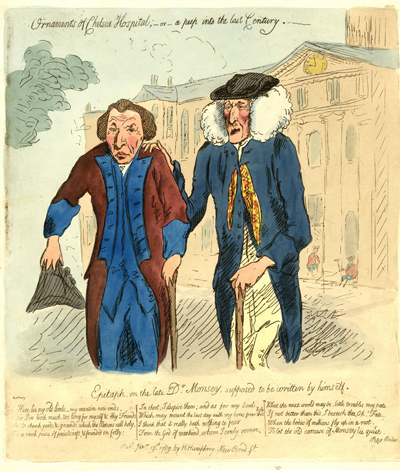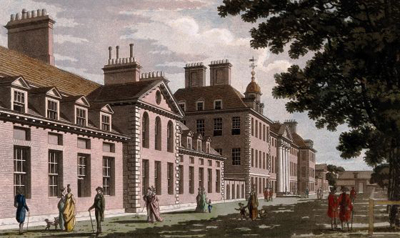Ornaments of Chelsea Hospital. . .
This print shows an aged Dr. Messenger Monsey (1694–1788), long-time physician to Chelsea Hospital, walking with the aid of a Pensioner on the hospital grounds. It was likely prompted by the news of his recent death (December 26, 1788), his unusual epitaph (included as the caption for the design), and the singular terms of his will in which he requested that his body be dissected for benefit of science.

© Trustees of the British Museum
The epitaph was reprinted in both the Whitehall Evening Post, for January 13, 1789 and the Morning Post and Daily Advertiser for January 15, 1789 where Gillray could have seen it before creating his print. The authoriship is variously attributed to Monsey himself or to Peter Pindar, whose works Monsey was fond of. In either case it is said to have aptly represented the acerbic wit for which Monsey was well-known.
Here lie my old limbs – my vexation now ends,
For I've liv'd much too long for myself & my Friends
As to church-yards & grounds which the Parsons call holy,
Tis a rank piece of priestcraft, & founded on folly;
In short, I despise them; and as for my Soul,
Which may mount the last day with my bones from this hole
I think that it really hath nothing to fear
From the God of mankind, whom I truly revere.
What the next world may be, little troubles my pate
If not better than this, I beseech thee, Oh! Fate,
When the bodies of millions fly up in a riot,
To let the old carcase of Monsey lie quiet.
A detailed account of Monsey's January 3rd, post-mortem dissection by Mr. Forster, Surgeon at Guy's Hospital, appeared in the Morning Post And Daily Advertiser, for January 05, 1789, Pg. 3.
Designed by Sir Christopher Wren, Chelsea Hospital (aka Royal Hospital, Chelsea) was founded by King Charles II as a home for old and injured soldiers from England's various wars. It's original capacity was intended to include 476 Pensioners, who would otherwise habe been left alone and virtually penniless. Gillray would have been familiar with the Hospital for at least two reasons. His father was an injured veteran who lost an arm while fighting at Fontenoy during the war of the Austrian Succession. If Gillray and the Moravian Church had not been able to support him, Gillray's father might very well have ended up as a Pensioner at Chelsea Hospital. Then too, until 1798, Gillray lived with his parents on Milman's Row in Chelsea which was only mile from the extensive grounds of the Hospital. His trips from Chelsea to Hannah Humphrey's shop in Westminster could have taken him right past the Hospital.

Chelsea Hospital
[November 15, 1800]
© Wellcome Collection
That being the case, the portrait of Monsey is likely to have been taken by Gillray from the life. The only other earlier portrait of Monsey by Mary Black (c.1737–1814) and Thomas Black (1715–1777) dates from 1764 and shows a much younger man.
Sources and Reading
- Commentary from the British Museum on Ornaments of Chelsea Hospital;.
- "Messenger Monsey," Wikipedia
- "Royal Hospital Chelsea," Wikipedia
- "Royal Hospital Chelsea,"
- A Sketch of the Life and Character of the Late Dr. Monsey
- Thomas Wright and R.H. Evans, Historical and Descriptive Account of the Caricatures of James Gillray #379.
- Thomas Wright and Joseph Grego, The Works of James Gillray, the Caricaturist; With the History of His Life and Times, p. 114.
Comments & Corrections
NOTE: Comments and/or corrections are always appreciated. To make that easier, I have included a form below that you can use. I promise never to share any of the info provided without your express permission.